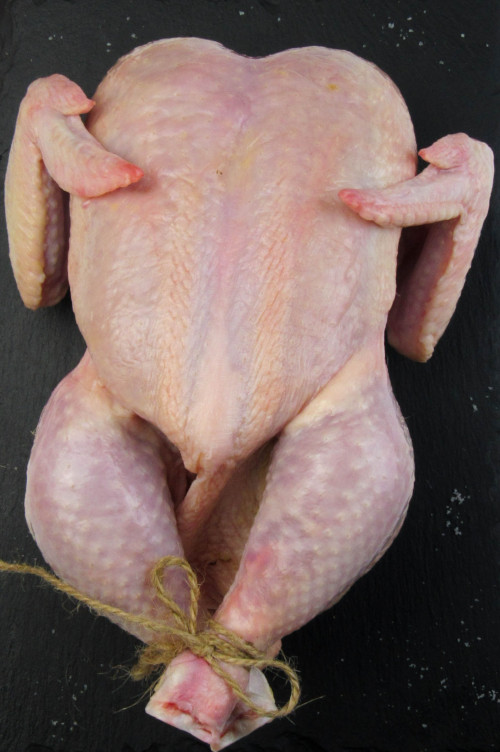Keeping and raising Orpington chickens for meat.

The Orpingtons are especially noted for their deep bodies and broad, full breasts, the long breast bone carrying almost as much white meat as is found upon a small turkey.
Can you eat Orpington chickens?
All varieties of Orpington, including the buff make excellent eating.
The Orpington was originally bred to be a dual purpose fowl to provide both eggs and meat and can be eaten like any other chickens. Orpington chickens take more than twice as long as regular broiler chickens to finish.
The flavour of Orpingtons is excellent, as a heritage chicken they have a firmer texture and benefit from being cooked slowly.
The standard practice in the old days was to raise the surplus cockerels for the pot and then eat the hens when they were no longer producing enough eggs to pay for themselves.
Are Orpington chickens good to eat?
In my opinion and when properly kept and fattened, the Orpington is one of the greatest table chickens ever, second only to the La Bresse. The meat is tender, juicy and of fine flavour. The skin is white, thin and tender.
The plump carcass and the fine texture of meat makes the Orpington good eating with plenty to satisfy the most hungry diner.
Below: Tied and trussed ready for cooking.

The cockerels weigh on average ten to twelve pounds and the hens from eight to ten pounds. Growing them on a little longer results in a heavier and fuller flavoured bird with a firmer texture.
How to raise Orpington chickens for meat:
The Orpington is a big, bulky chicken, and does not grow as rapidly a hybrid broilers.
It is somewhat heavy in bone and carries a fair amount of flesh which takes time to cover the bones. It is worth the wait.
Orpingtons are especially good to raise as a meat bird if you enjoy the leg and thigh meat which is juicy and decidedly superior to what is found upon more active fowls.
The Orpington fattens fairly easily and is a docile chicken to have around.
In young birds the breast meat is not very abundant, considering the size of body.
All chickens that are going to be processed for meat should be kept confined in a run and not allowed to roam to much. They also need to be fed a broiler finishing feed during this time and then starved for 24 hours before slaughter.
Orpingtons kept in an ark on pasture or grass will make for a tastier chicken.
What is the best age to butcher and process Orpington chickens?
Orpington chickens put on a pound of meat for every month of their age, up to ten months. You can expect a six month old bird to provide about 6 pounds of meat, excluding the bones.
Orpingtons are a heavy, all-purpose fowl which matures quite quickly for a large heritage breed.
The Orpington is quick to mature for a heritage breed and can be ready to process from 20 to 40 weeks old. Exactly how old depends on what size you need the carcass to be.
Below: Table showing maximum weigh of an Orpington carcass at slaughter.
| Age in months. | Weight of hen. | Weight of cockerel. |
| 6 months. | 5 lb (2.2 Kg) | 6 lb (2.7 Kg) |
| 7 months. | 6 lb (2.7 Kg) | 7 lb (3.1 Kg) |
| 8 months. | 7 lb (3.1 Kg) | 8 lb (3.62 Kg) |
| 9 months. | 8 lb (3.6 Kg) | 9 lb (4.0 Kg) |
| 10 months. | 9 lb (4.0 Kg) | 10 lb (4.4 Kg) |
| 11 months. | 10 lb (4.4 Kg) | 12 lb (5.4 Kg) |
| 12 months. | 11 lb (5.0Kg) | 14 lb (6.3 Kg) |
A fully grown and fattened 12 months old Orpinton chicken can have almost as much white meat as a young turkey!
The plumage should be close and not loose, the skin thin and fine in texture, and flesh firm. Young and immature Orpingtons can have a light and bony feel and you should wait until they fill out and firm up before slaughtering.
Birds to be processed should be kept confined and fed a higher carbohydrate diet for a few weeks before being slaughtered, this will prevent the meat from becoming tough and the birds will put down a thin layer of fat under the skin helping to keep the meat moist.
They are of tremendous size and average very large, fully developed cock birds, often weighing fourteen and fifteen pounds, and hens ten and eleven pounds.
The Orpington is a very long and deep bird from the back to the hock, and have great breadth. They show this effect while living, but the carcass has the same characteristic and they have an abundance of delicious meat on their well rounded breast that is of a high quality.
